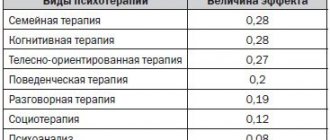- Emotional disorder in children
- Mixed behavioral and emotional disorder in children
If a patient is diagnosed with an emotional disorder, it is often accompanied by the development of mental illnesses: neuroses, at various stages of schizophrenia. Since psychiatry, as well as psychologists, study this category of disorders, it is important to consider all possible aspects of the disease.
Emotional and behavioral disorders (psychiatry)
Disorders of emotions and behavior can act as an independent, primary disease, or become a side symptom as a result of neurosis, depression, or severe nervous shock.
Disorders of behavior and emotions in a child
In a child, the disorder manifests itself as the inability to independently plan one’s own time, control emotional manifestations and reactions, and organize behavior in accordance with generally accepted norms.
The main symptoms include the following:
- Aggressiveness
- Refusal to obey adults
- Excessive cruelty
- Disobedience
- Pugnacity.
The reasons why a child may develop a behavioral disorder can be divided into several categories:
- Physiological. Manifests itself in hormonal changes and disturbances in metabolic processes. As a result of the development of cerebral palsy, epilepsy, schizophrenia, as well as increased irritability.
- Psychological. Occurs as a result of the child's emotional instability. He may develop an unrealistic self-esteem, a depressed emotional background, and constant self-blame may prevail.
- Family relationships. As a rule, the disorder occurs as a result of constant conflicts between parents. Most often they exhibit immoral behavior, use drugs or alcohol, and often have mental disorders.
Before starting treatment for a pathology, the treating specialist tries to establish the cause of the disorder, as well as organize testing for the child to find out how much it is progressing.
Classification
Emotional disorders can be independent disorders or components of other mental illnesses. Pathological intensification of emotions is manifested by an increase in their intensity while maintaining adequate content. This group of disorders includes:
- Depression.
The structure of depressive states is dominated by low mood and depression. Patients feel anxiety and a feeling of inferiority. They perceive everyday difficulties as insurmountable and provoke crying, despondency, and reluctance to do anything. - Mania.
Manic states are manifested by elevated mood, accelerated rate of mental activity, and increased physical activity. A person becomes hyperactive, fussy, strives for achievements, to learn new things, but he lacks concentration and focus. - Euphoria.
In euphoria, people are dominated by carelessness, elevated mood, and infantility. Critical abilities and serious attitude to situations decrease. Passivity and excessive complacency do not allow you to perform daily duties.
Another option for psycho-emotional disorders is weakening of emotions. Regardless of the events taking place - joyful, sad, provoking aggression - people remain indifferent or experience weak feelings that do not correspond to the significance of the situation. Examples of such disorders:
- Emotional flattening.
With some mental illnesses, for example, with schizophrenia, emotions become impoverished - they become monotonous, primitive, and weakly expressed. In severe cases, only some manifestation of dissatisfaction in situations of discomfort remains. Other events - meetings with relatives, the loss of a loved one - do not evoke any emotions. - Apathy.
A state of apathy is typical for patients with depression. There is a general decrease in all emotional reactions. The patient is indifferent to what is happening, unable to experience joy, sadness, fear, anger. Often apathy is combined with a decrease in motor activity and abulia - pathological lack of will, the inability to begin any action.
When the mobility of emotions is impaired, a person’s ability to control the duration of the experience changes. This is manifested by stuckness, suddenness, or rapid uncontrollable changes in emotional states. There are several variants of the dynamic aspect disorder:
- Emotional lability.
With affective lability, emotions arise easily, quickly replace each other, and depend on fleeting external events or random memories. Such conditions are considered normal in early childhood, when a child’s tears suddenly give way to laughter, but in adults they are a sign of emotional disturbance. - Explosiveness.
This term refers to emotional explosiveness. After a period of calm, a person suddenly demonstrates anger, irritation, anger, and then just as quickly returns to a state of balance. During explosive outbreaks, aggression and provocation of conflicts are possible. - Inertia.
Synonyms for inertia are stuckness, stiffness. Such people experience one emotion for a long time, cannot be distracted and change it at will, and are in a state of irritability, melancholy, and anger.
The most striking psycho-emotional disorders are disturbances of adequacy. Inappropriate emotional manifestations are classified as pathological according to the content criterion: what a person feels has no connection with his thoughts or external events. This group includes:
- Inadequacy.
With emotional inadequacy, a person experiences and demonstrates emotions that are completely inappropriate for the situation. For example, laughter occurs in response to the news of the death of people, outbursts of anger when meeting a loved one (mother, friend). - Ambivalence.
People with schizophrenia often experience ambivalence of experiences - the simultaneous existence of opposing emotions. This condition is difficult for a healthy person to understand. Outwardly, it manifests itself as a constant, unconditional change of joy and melancholy, tenderness and anger, anger and tearful weakness. - Emotional tension.
Inappropriate experiences may include pointless fear, unmotivated anxiety, an inexplicable feeling of anger or dissatisfaction with oneself. In such conditions, people are in emotional tension, but cannot determine what is causing it. Usually they say: “the soul is restless”, “the soul suddenly sinks into the heels.”
Mixed emotion and behavior disorder
It is characterized by a disorder of emotions and behavior equally, where a person exhibits excessive aggressiveness, suffers from a persistent depressive state, and increased anxiety.
Emotional disorder in children
A child, compared to an adult, perceives all events more acutely, and therefore reacts much more emotionally. Accordingly, when an emotional disorder occurs, the symptoms manifest themselves much more intensely.
In order to prevent pathological development of the situation in the future, it is recommended to use play therapy. This will help avoid underdevelopment at the psychic and mental levels. Also, game simulators that replicate life conditions will help the child adapt better and realistically perceive the surrounding aspects.
Psychodynamic work is also often used, which is accompanied by a psychologist. Psychoanalysis involves identifying the causes of the formation of emotional disorders.
Reasons for the development of the disease
The incidence of ENRL in the population is 2-4%. It is predominantly detected in women. The clear reason for the development of the pathology is unknown. However, in many patients a hereditary predisposition is clearly identified.
Risk factors for the development of pathology include:
- Organic disorders in the brain: consequences of traumatic brain injuries, malignant neoplasms and other lesions.
- Minimal brain dysfunction occurring in childhood. The condition is characterized by a temporary disruption of the blood supply to the structures of the central nervous system.
- Negative emotional atmosphere in the family, including aggressiveness or cruelty of parents, authoritarian parenting style, demand for total obedience from children.
- Lack of parental attention and affection in childhood.
As a rule, several risk factors are identified in patients with emotionally unstable personality disorder.
Emotions and emotional disorders
A physiological state of the body, characterized by subjective coloring, which is expressed in types of experiences, ranging from positive to sharply negative manifestations.
Regarding emotional disorders, this is a whole complex of manifesting symptoms, which are often characterized by irritability, aggression, sudden changes in mood, a tendency to deviant behavior, as well as the inability to control one’s own actions.
Mixed behavioral and emotional disorder in children
Mixed behavioral and emotional disorder in children has similar symptoms as in adult patients. Behavior is often deviant in nature, deviating from social norms. As a result, the child becomes more aggressive, signs of depression are often observed, as well as increased anxiety.
Before starting treatment, you first need to be tested by a psychologist and psychotherapist. If a primary neurotic or mental illness is diagnosed, against which a mixed disorder develops, physiotherapy, complex work of psychotherapists and psychologists, and auxiliary medications are most often used.
Symptoms of mood disorders
External manifestations depend on the type of disorder and the severity of the disease.
Often people with affective disorder do not notice or ignore the symptoms of the disease. This is due to the fact that they lack criticism of their own condition. Therefore, attentiveness and care from loved ones is important here.
The main points to pay attention to include:
- sudden mood changes from “plus” to “minus”, which last from 2-3 weeks to several months;
- changes in behavior and perception of oneself and the world around us, for example, an increase in self-worth;
- jumps in mental activity and speech: sometimes fast and indistinct, sometimes slow and inhibited.
Let's look at the signs of an affective disorder depending on the mood phase. A depressive episode is characterized by:
- nighttime insomnia and/or daytime sleepiness;
- depressed depressed mood;
- apathy;
- retardation in movements;
- speech is slow;
- lack of appetite;
- dark thoughts, sometimes suicidal;
- lack of interest in previous hobbies.
In the manic version of the disorder, the opposite signs are observed:
- increased appetite;
- excessive mobility, lively facial expressions, active gestures;
- rapid, slurred speech, jumping from one topic to another;
- a person takes on a large number of tasks, but rarely brings them to completion;
- increased sexual desire;
- high distractibility, inability to concentrate on one thing;
- delusional thoughts and ideas regarding one’s own importance.
With bipolar disorder, a person is thrown from one extreme to another. The depressive phase corresponds to the clinical description, and during the manic phase, aggression, reckless actions, and severe irritability can be observed. In this state, a person does not control himself and is capable of harming himself or others.
Correct diagnosis of affective disorders is possible only through consultation with a psychotherapist or psychiatrist. This is because the symptoms of some emotional disorders may overlap with other mental illnesses, such as schizophrenia.
It is almost impossible to lower or improve your mood on your own. Over time, episodes will appear more often and become longer lasting, so it is important to consult a specialist at the initial stage of the disease.
Diagnosis of disorders
At the Leto mental health center, a study is carried out with the participation of several specialists to more accurately identify the main cause of deviations.
Doctors use:
- Detailed survey.
- Inspection.
- Psychodiagnostic tests.
- Observation.
- Use of information provided by the patient's relatives.
Treatment
Treatment for emotional disorders includes:
- Taking medications is prescribed only by a doctor for organic brain damage and severe psycho-emotional abnormalities. The choice of medications depends on the specifics of the disorder. For apathy, depression and suicidal tendencies, antidepressants are prescribed. Taking tranquilizers is advisable for panic attacks, attacks of uncontrolled aggression, and obsessions. For increased excitability, antipsychotics are prescribed.
- Psychotherapy is the basic method of treatment. The correction program for psycho-emotional problems is developed individually, taking into account the causes of behavioral deviations, the patient’s condition and medical history.
The patient may be hospitalized in a hospital. The reasons for this decision include the statement of the patient’s relatives about the need for his hospitalization in a psychiatric clinic. Such a measure is provided if the patient’s behavior threatens the health and lives of others.
Consultations
Psychotherapist
Group psychotherapy
Psychologist
Family psychotherapy








